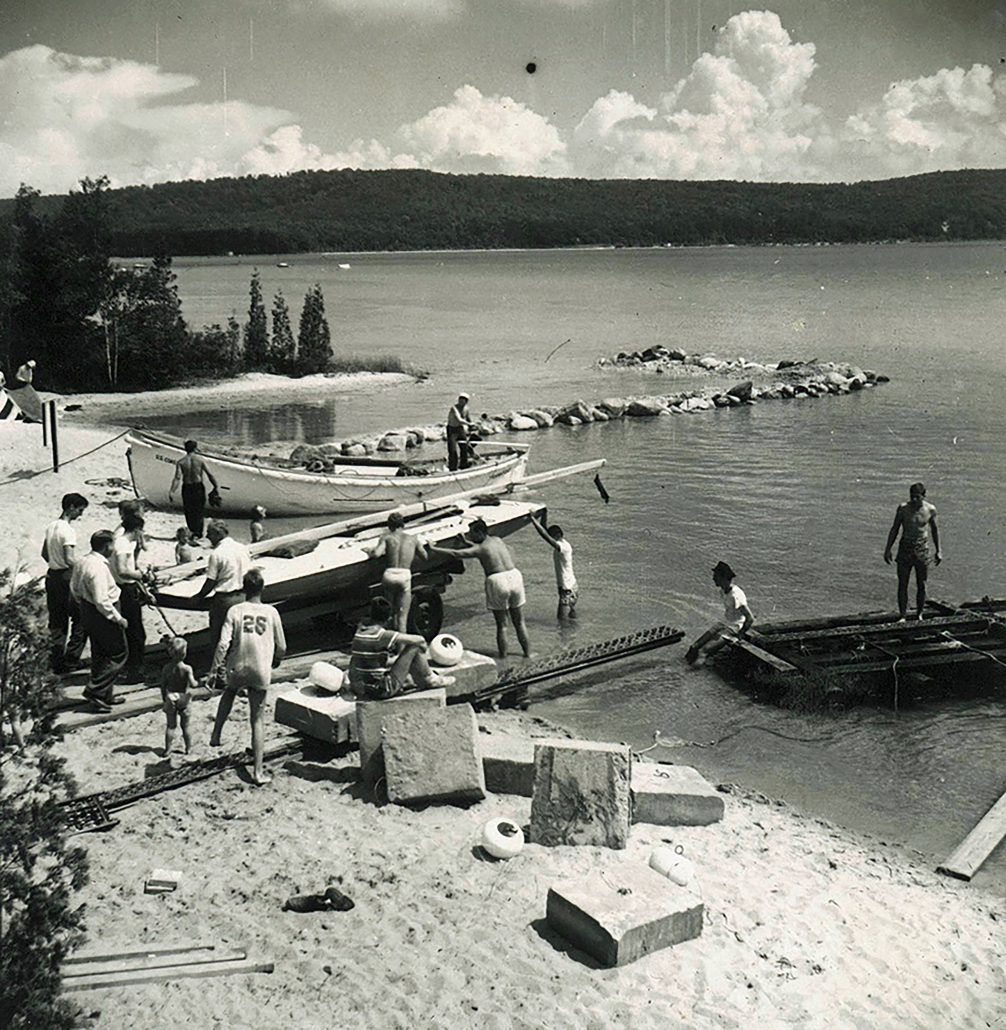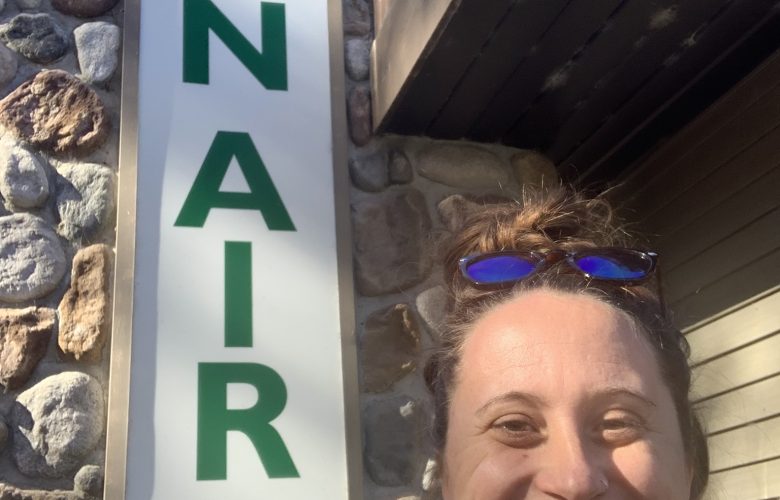A history of the Crystal Lake Yacht Club
By Grant Brown, Jr.
Current Contributor
Crystal Lake is ideal for water sports. Its cool, clear water invites swimming, water-skiing, canoeing, motor boating, and sailing.
But back in 1930, none of these activities—especially sailing—were very much in practice.
That was about to change.
In September 1930, five gentlemen, summer residents of Crystal Lake, met in Chicago to form a sailing club, soon to be known as the Crystal Lake Yacht Club (CLYC). In so doing, they initiated an activity that would, in time, become a significant part of life during the summer on Crystal Lake.
The club bought three Class “C” inland scows, which were made available to members for a half-day at a time, and hired a sailing master to teach sailing and start races. Racing began in the summer of 1931.
The “C” scows were fun to sail. They had a blunt bow, but when tipped, presented a very sleek form through the water. And they tipped a lot!
The rule when sailing upwind was to have about two inches of deck under water. Instead of a centerboard, the boats had bilge boards, one on each side. The leeward board was always down to keep the boat from side slipping, and the windward board was most of the way up. The crew member was expected to stand on the exposed part of the windward board while holding onto a monkey rail, to keep the boat from tipping over. That worked well when there was only one crew member, but on windy days, when a second crew member was needed, the second crew had a very difficult time finding space on the board. Both crews expected to get wet.

The “C” scows were—and still are—20 feet long and 6.5 feet wide with a single sail.
The boats that the Crystal Lake Yacht Club bought were of the gaff rig—a gaff being a boom at the top of the sail, attached to the mast. Before long, club members began buying their own boats of the Marconi rig (no gaff), which were faster upwind and easier to right when tipped over.
For several years, boats of both rigs competed in races on Crystal Lake, though there was a significant disparity in their speed.
In the mid-1950s, a major change occurred in the sport of sailing. Dacron became the material of choice for sailmakers. Dacron had several advantages over cotton, which shrank when wet and often did not go back to its original shape when dried out.
For years, the club avoided sailing when there was a threat of rain. With Dacron sails, it did not matter.
Dacron retained its size and shape. Dacron was more dense than cotton and produced more power. And it was easier to handle. Cotton sails had been removed from the boats each night and either folded or stuffed into a bag. (There were many discussions about which was best—folding or stuffing.) But Dacron could be left on the boat all summer.
Moreover, cotton sails had to be broken in by sailing for several hours in moderate winds while the sail stretched to its final shape. No “breaking in” was required of Dacron.
The hulls were planked with cedar and varnished, rather than painted. The result was very attractive, but significant maintenance was required. Nearly every spring, it was necessary to sand and varnish the hull. (There was nothing like the urethane varnishes of today available.)
When the boat was put in the water, it nearly always sank. Cedar expands when wet and contracts when dry, more so than most woods. Thus the seams open up in the winter, and the boat sinks in the spring.
The general rule was to leave a boat sunk for three days, then pump it out. After that, it would float for the rest of the summer.
At first, CLYC members with sailboats owned property on Crystal Lake and moored their boats in front of their homes. Unlike most boats at anchor, the “C” scows often began sailing on their rigging alone and tipped over in a strong wind.
In the late 1930s, two club members solved the problem by building wooden hoists to keep their boats entirely out of the water. Before long, nearly everyone had a hoist. Surprisingly, the boats remained watertight all summer, even though out of the water—in a hoist—most of the time.
Initially, the races were started off the Congregational Summer Assembly (CSA) raft but soon moved to the Borwell raft, about a half-mile to the north.
In 1936, the club joined the Western Michigan Yachting Association, which held a regatta at one of the member clubs each summer. Crystal Lake sailors began to compete.

By 1941, the club had 27 member families and was badly in need of a clubhouse but had no funds with which to even consider building such a facility. In fact, CLYC had run a deficit each summer and had been bailed out by a few wealthy members. Two of those members came through in a very big way.
Charles W. Seabury and Robert C. Borwell arranged for an attractive clubhouse to be built on land owned by the Crystal Downs Country Club at the west end of Crystal Lake and for the CLYC to pay the Downs $1 a year for use of the property.
The CLYC built a long wooden dock where boats could tie up and from which races could be started. They also placed buoys at various points along the north and south shores to be used as markers for the race courses.
In 1947, the club initiated a junior fleet with the purchase of six Wood Pussies by individual members.
A Wood Pussy is 13.5 feet long with a single sail. It is a more standard type of boat, with a pointed bow, and is designed with a shallow rudder, so that when the boat tips, it comes out of the water and the boat heads into the wind. Thus, it is nearly impossible to tip one over—a safety factor for young sailors.
The fleet of Wood Pussies fulfilled its purpose, growing young sailors to later sail “C” scows. Many adults liked them, as well, preferring them to “C”s, which required considerably more skill and energy to sail. By 1965, the combined fleet of Wood Pussies totaled 35 boats and was said to be the largest in the country.
In the mid-1940s, the club initiated a Ladies “C” scow competition. At the time, nearly all “C”s were owned and sailed by men, but there were a few female sailors who were very able, and this gave them an opportunity to race separately.
The CLYC fleet increased in size, as a few male sailors gave up their boats for women to sail. That worked out well, because the Ladies competition was held during the week, and the open competition was on the weekends. The Ladies “C” competition continued through 1975.

In 1949, the club hosted its first Western Michigan regatta. The regatta was expected to bring about 80 boats. At that time, there was a rule that every boat competing had to stay in the water for the entire regatta, which was three days. That meant there needed to be moorings. The club had 50 cement blocks, 900 pounds each, made to act as anchors and provided buoys of a brand new material from Dow Chemical—Styrofoam.
Then came the problem: how to get the anchors into the water.
No one could lift a 900-pound block, and no one had a boat that could carry them to their proper destinations.
So the club built a raft and hired a crane to lift the anchors, and the Frankfort Coast Guard Station provided a boat to tow them to their proper locations, spread out about a half-mile to the north and south of the club. (They are still there, and some are in use today.)
The regatta was a success, with a Crystal Lake boat taking second in the “C” class, the highest a CLYC boat had ever placed in a West Michigan regatta.
In 1966, two major changes occurred. Butterflies—boats that are 12 feet and two inches long, with a single sail and a bow not unlike that of the “C” scows—and “E” scows were brought to Crystal Lake.
The Butterfly was meant to be a junior fleet boat, and it was a very good choice. Butterflies were less expensive than Wood Pussies and could be stored at the yacht club by simply pulling them up on the beach. In 1970, the Wood Pussy was dropped as a junior fleet class. In time, more and more Wood Pussies left Crystal Lake so that, by the late 1990s, there were only two left.
The Butterflies caught on immediately. While about 10 members had been sailing Wood Pussies in the juniors, Butterfly fleets soon numbered in the 20s. Adults, particularly women, began sailing them as well, and they remain popular today.
The “E” scow is 28 feet long, with a main, jib, and spinnaker. It is a very fast boat and requires more skill than a “C,” but it is also arguably more rewarding.
The CYLC founders had originally considered buying “E”s instead of “C”s, but ultimately felt they were too much of a “racing boat.” However, by 1966, many club members had sailed Western Michigan regattas—and a few had actually won them—so they were ready for a new challenge. Several of the top “C” sailors purchased “E”s.
The “E” is much more expensive to buy and to keep competitive than the other classes on the lake—consequently, there are fewer sailing.
Ten “E” boats on the starting line is considered substantial, while Butterflies often number in the twenties and MCs—brought to the lake in 1991—number in the high teens or greater. On the other hand, it takes three, and often four, people to race an “E,”, so a 10-boat fleet gets 30 to 40 people out on the lake.
Additionally, because they are big and fast, “E”s are fun to watch. A 10-boat fleet often draws a like number of motorboats following the race.
“E”s are also powerful—an “E” can pull water-skiers in a 10 to 15 mile-per-hour wind.
In 2009, the Crystal Lake Sailing School was formed. Though operating on land leased to the yacht club by Crystal Downs, it is not part of the club. Anyone can attend, and the school makes an effort to make lessons available to children in the local schools.
Classes are held one week at a time and conducted in Optis, a dinghy-like boat that is quite stable and offers a young sailor the opportunity to learn about sailing without danger or fear.
Classes start with the basics and then move on to more advanced sailing and skills necessary for racing. Additional advanced instruction is offered in Butterflies.
The school has been successful, providing instruction for more than 1,000 students since its formation. It has brought new members into the club, but more importantly, it has introduced many young people to the experience of sailing on Crystal Lake.
Sometime in the 1960s, most boatbuilders began building boats out of fiberglass instead of wood. Fiberglass did not leak, did not need to be refinished each year, and lasted indefinitely.
Gone were the days of sanding, varnishing, and pumping boats out each summer.
For the first 25 years, nearly everyone who sailed at the yacht club lived on Crystal Lake and moored their boats in front of their property. But that was changing.
Several people who owned boats but did not have lake property kept their boats on trailers behind the yacht club and launched them each time they sailed by running the trailers into the lake. That, obviously, was not satisfactory. So in the late 1960s, the club purchased land immediately to the south of the club, and in 1970, CLYC installed a hoist. (Today, many more boats are stored and launched at the club than are kept on the lake.)
While the club was growing, other sailing was developing on Crystal Lake.
Crystalaire Camp for Girls—and boys, when the camp became co-ed—made boats of several classes available to campers. The camp offered “C” scows, Sunfish, Butterflies, and Lightnings to young sailors. Many enjoyed harnessing the wind of Crystal Lake and discovering the quiet beauty of being on the lake with no noisy motor to disrupt the scene.
Others around the lake enjoyed—and still do today—the experience of mastering the elements in a sailboat. At any one time, one can see Lightnings, Snipes, dinghies, Thistles, O’Day sailors, Lasers, and other one-design classes of boats moored or sailing around the lake. Racing is not necessary for one to enjoy the challenge of sailing, and the satisfaction that comes with mastering the elements.
During the 1970s and ’80s, other classes were sailed at the club. Hobie 16s were sailed for several years. They were appealing because they were relatively inexpensive, not too difficult to sail, and could be stored by pulling them up on the beach. And they were fast. On the right day, they could actually beat the “E”s.
The ability to store on the beach was both an advantage and a disadvantage. When stored on the yacht club beach, the Hobies took up a very large amount of space, taking up room normally used for storing Butterflies and encroaching on the swimming beach. In time, members dropped out for various reasons, and by the late 1980s, racing of Hobie 16s was discontinued on Crystal Lake.
Other classes were tried and abandoned until 1991, when two MC’s were brought to the lake. Sixteen feet long and a scow, like the “C”s and E”s, the MC class caught on immediately and grew rapidly—and for good reason.
MCs could be sailed by one person on most days and offered a challenge to race competitively. For many, the ability to sail without the hassle of finding a crew was a major enticement. And the challenge was real.
The skipper, as the lone person on the boat, was responsible for everything—manipulating the five sail controls, setting the bilge boards, steering, and hiking out to keep the boat right side up. On a particularly windy day, one might take a lightweight crew, but even then, the crew was usually there for hiking only. Before long, the fleet numbered in the teens, and today it is consistently in the high teens or the low 20s on Crystal Lake.
The advent of the MCs brought on the temporary demise of the “C” class. The boat that had defined the club for its first 35 years—and which had been a part of the club for many more—finally lost its popularity.
The loss, however, was not permanent.
In 2017, “C”s began racing again, and while not a major part of the club, several boats continue to show up each weekend to compete.
Since first hosting the Western Michigan Regatta in 1949, the club has hosted the Western Michigan Association approximately every five years. Fortunately, the rule requiring boats to stay in the water for the entire regatta has been long gone—today, nearly all boats are hauled out after each day of racing.
Crystal Lake is especially well suited to hold a large regatta. The wind is usually steady, and there is plenty of room for a long starting line and long first leg of a course. The latter is important because it allows the fleet time to stretch out, so the entire fleet does not reach the windward mark at the same time. The size of the lake also provides room to run races in two or three classes at once, without interfering with each other.
The club held its first national championship regatta in the early 1970s. Fifty-nine “E”s attended, and the regatta was a big success. Like members of the Western Michigan Association, most participants expressed a desire to return.
Over the years, the Crystal Lake Yacht Club has hosted national championship regattas in the “E”s, MCs, M 17s, “A”s, Wood Pussies, and Butterflies.
Early in the 21st century, the Wood Pussy class made a comeback on Crystal Lake. One club member, recently retired, who had sailed the boats while growing up, started the resurgence. He was told that if he could bring two boats to the starting line, he could have a race. He got his two boats, and by the end of summer, was getting five.
Over the next several years, he drove all over the Midwest and the East Coast looking for boats. He found them in old garages and barns, usually abandoned, and often in run-down condition. He bought them, brought them back to the lake, sold them to people who wanted to sail, and helped to fix them so they could. Before long, he was bringing 10 or more boats to the starting line.
Today’s Wood Pussy fleet at the Crystal Lake Yacht Club is different from other fleets in the club—nearly everyone is retired and likes to do more than just sail.
Once a week, there is a “lean in” after the races, with wine, hors d’oeuvres, etc. They are quite well attended, and people other than sailors are invited. Often the number of non-sailors approaches the number of sailors. Additionally, there are moonlight sails, and their season extends several weeks past the closure of racing for other classes at the club. So the Wood Pussy fleet is once again alive and well.
Sailing has become a major activity for many people, young and old, in the summer on Crystal Lake. For some, it is their prime activity. Almost every day, one can find 10 to 25 boats racing, and others around the lake simply enjoying the satisfaction that comes with challenging the elements. At the Crystal Lake Yacht Club, anywhere from 30 to 40 Butterflies are stored, along with around 50 additional boats.
The gentlemen who decided in 1930 to form a sailing club could never have imagined what they put in motion, but were they here today, they would be pleased.
Sailing Crystal Lake: A Short History is a 24-page book—the Benzie Area Historical Society’s most recent publication, with photos compiled from its archives and private individuals—by Grant Brown, Jr., who began racing sail boats on Crystal Lake in 1947 for 10 years, continued to do so in Boston and St. Louis, then returned to live in Frankfort and raced as recently as 2005. He worked for S.D. Warren Company, a paper manufacturer for 37 years; he spent eight years in the U.S. Coast Guard Reserve, where he learned navigation and shipboard procedure. This article is an overview of the book, which traces the development of sailing on Crystal Lake from the early 1900s through the present day. Heavily illustrated with photos from the past and present, the book follows the advancement of sailing from the 1930s to the current day, with hundreds of people on the lake each week sailing boats.




